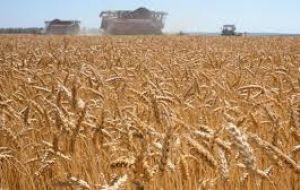MercoPress. South Atlantic News Agency
Wheat has become a most promising crop, following on the Ukraine war and India's ban on exports
 India's export ban has only come to increase an already difficult situation created by the Russian invasion of Ukraine, two of the world's leading exporters of wheat
India's export ban has only come to increase an already difficult situation created by the Russian invasion of Ukraine, two of the world's leading exporters of wheat The intense heat wave in India which has turned out to be the hottest spring in the last one hundred years is having its impact on people, fauna and agriculture. Thermometers recording 50 degrees centigrade, and the lack of water, has forced the government in New Delhi to halt all wheat exports, in anticipation of any shortages that could lead to extreme situations.
According to the statement, only exports backed by letters of credit issued before the ban was imposed, May 14th., will be allowed, and the only other exception is for countries that request supplies “to meet their food security needs.”
However the measure is not final and can be revised according to the government.
This has had an immediate impact in the international agriculture commodities market, forcing grain producing countries to increase prices or those in the southern hemisphere to plan greater harvests to meet the global demand. Likewise the impact on wheat based foods, bread, pasta, and flour, will also necessarily extend to feed lot cattle breeding.
India has only come to increase an already difficult situation created by the Russian invasion of Ukraine, two of the world's leading exporters of wheat, who are concentrated in the war instead of sowing wheat and other grains.
But according to world agriculture experts, the ban of Indian shipments is likely to be advantageous for countries such as Argentina, Australia, South Africa, Brazil, potentially great exporters of wheat and flour.
In effect Brazil already a world leader in soybeans and corn supplier, is planning to add wheat to its cereals sales list, following on a considerable crop in southern states. Traditionally Brazil, a net importer of wheat, would buy the cereal from Argentina but that country's erratic farm policies have convinced their Mercosur partners to also become a wheat power house.
In January and February 2022, Brazil saw record wheat exports in value and volume alike (1.48 million tons; + 184.2%). The main destinations were Saudi Arabia (US$ 85.63 million; 19,6% share); Morocco (US$68.16 million; 15.6%); and Indonesia (US$65.70 million; 15%). The state of Paraná accounts for almost half of Brazilian wheat production and has a 30% milling volume capacity.
Besides Brazilian plantation began to improve over time as the quality of different wheat cultivars improved. “Our cultivars in Brazil have improved a lot in terms of quality, so we expect a gain in productivity and an increase in the planted area. Therefore, we are optimistic that the crop will be excellent”, said analyst Paloma Venturelli, vice president of Sinditrigo-PR.




Top Comments
Disclaimer & comment rulesCommenting for this story is now closed.
If you have a Facebook account, become a fan and comment on our Facebook Page!